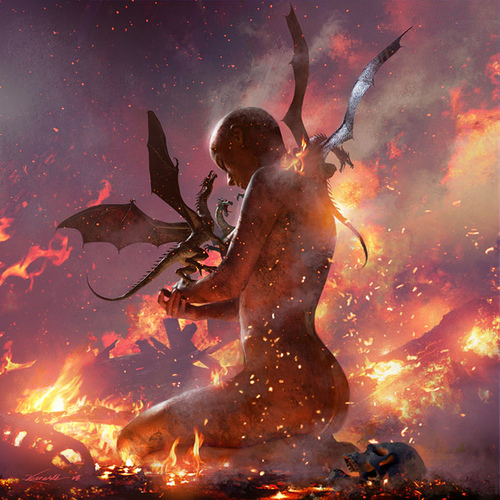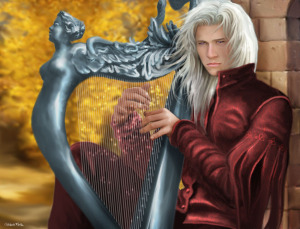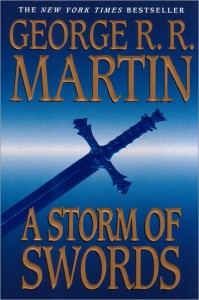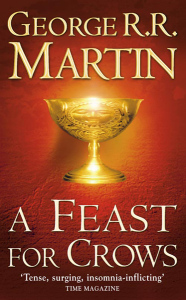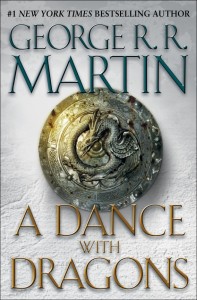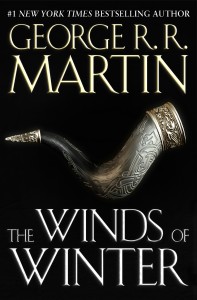 I could probably write a whole series about things that I like more in theory than I do in practice in the pop culture world.
I could probably write a whole series about things that I like more in theory than I do in practice in the pop culture world.
A few examples: Sara Bareilles, Fountains of Wayne, Hoosiers, the Elder Scrolls series, and Pandora.
But the #1 entry on that list might be fantasy books. It’s crazy for me to admit that I find the genre overrated: I consider myself a fan of fantasy. I love getting lost in fictional worlds full of mystery and intrigue and magic, being taken on sweeping quests, and imagining fantastical beasts and settings.
Yet, can I really call myself a fantasy fan if I can’t get through a single damn book of the genre? I’ve probably started 20 or 25 fantasy series in the past few years… and I’ve finished maybe two or three of them.
The idea of fantasy is so appealing, yet something got lost in translation. Or, rather, lots of things got lost in translation. Some of the problems: bland heroes; slow, formulaic starts; over-reliance on Tolkien-esque tropes and story elements; cackling villains that lack humanity or empathy; emphasis on worldbuilding ahead of compelling characters and stories; lots of moral absolutism; and more.
(Also, I’m an impatient son of a bitch. A book needs to be REALLY addictive for me to power through the massive page counts associated with many of these series.)

The Wheel of Time: some light summer reading (source)
Enter A Song of Ice and Fire. George RR Martin’s series, which has received an explosion in popularity thanks to Game of Thrones, the HBO adaptation of the series, is exactly the type of story I hope to read when I open the cover of a fantasy book. A few things I love about it:
The unforgettable characters
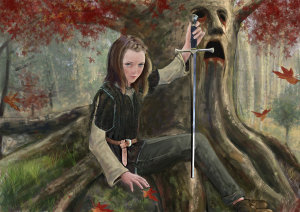
Stick ’em with the pointy end (source)
ASOIAF is jam-packed with some of my favorite characters in any story I’ve read. Martin takes the time to develop most of the series’ major players into multi-dimensional creations, and gives them all really unique and consistent personalities so you feel like you know them.
Who can forget Tyrion Lannister, the silver-tongued midget? Arya Stark, the fearless tomboy? Jon Snow, the rejected bastard?
And while many of the characters sound a bit cliche on the surface, Martin makes them feel unique with his rich writing and unpredictable arcs for each character.
The twisty, engrossing plots
It’s not just the people who inhabit Martin’s worlds: It’s what they do and the unpredictable ways they do it.
This is especially true of the series first three (and best three) books: Characters all have rises and falls — mostly falls — and cross paths in unexpected ways.
These are immensely dark books. Martin became famous for keeping none of his characters safe: Several main protagonists who seem poised to be around for a long time are often killed in startling scenes.
But the series’ reputation for being “dark” just because it kills beloved characters is an oversimplification: What make these stories so effective is not just that characters die, but that the plots don’t follow the expected beats. The stories are usually unpredictable and satisfying.
The varied perspectives
Time magazine famously called ASOIAF the modern American equivalent of Lord of the Rings.
LotR is a product of England circa World War 2. As much as Tolkien liked to deny the allegorical elements of the series, the parallels are definitely there: A looming big bad guy who threatens the world’s safety (Hitler/Sauron); a powerful weapon that might be more danger than it’s worth (nukes/the ring); a struggle of good to overcome evil in the name of necessity and survival as well as honor (England in WW2/The Fellowship’s journey).
Many of these traits have been mainstays of fantasy in the ensuing decades, even through well-reputed modern day series like Wheel of Time.
But Martin gives us something that feels more honest in America’s melting pot: Right and wrong is all a matter of perspective. There’s no central evil, nor an unambiguous “good.” People obey different laws and believe in different religions. Success is a capitalistic climb to the top, not a triumph of good over evil. Institutions hurt the “smallfolk” of the world.
He brilliantly sets this up from the beginning, giving us numerous conflicts fraught with complexity, irony, and moral shading in just the first few chapters.
Consider one early scene: The rebel king Robert — who in most other series would be heroic and wise — decries his former foe Rhaegar Targaryen — who in most other series would be the devilish face of an evil empire.
But Ned Stark reveals in flashbacks that Rhaegar was often wise and good, usually acting justly and empathetically.
And we spend major portions of the book following Rhaegar’s sister, Daenerys, who is just a young girl trying to make her way in the world, not evil reincarnated as King Robert implies.
And yet, the point of this is not that Robert is wrong and misguided. It’s that good and evil are not absolutes in this world. Everyone in ASOIAF believes they are the good guy — that this is THEIR story — and everyone is at least a little bit right. (Except that little shit Joffrey.)
The vast, compelling universe
ASOIAF has a huge, intriguing world full of history, mythology, unknown magic, uncharted lands, and a sense of destiny. It’s one of the only worlds in any fiction where the world has felt so richly developed and compelling that I’ve wanted to eat up every bit of information I could get my hands on. There’s a lot of info out there (especially thanks to the new World of Ice and Fire book), but what I love most about the universe is that there’s so much we DON’T know. It inspires so much curiosity.
We don’t know what caused the Doom of Valyria, or why The Others are marching south, or what the significance of the mysterious “glass candles” is, or what mysteries are hidden in Sothyros and Ulthos, or what lies in the “Shadow” beyond Ass’hai, or if anything exists beyond the Sunset Sea, or… etc. etc. etc.
It’s a world full of intrigue and mystery, and I love every minute I spend in it.
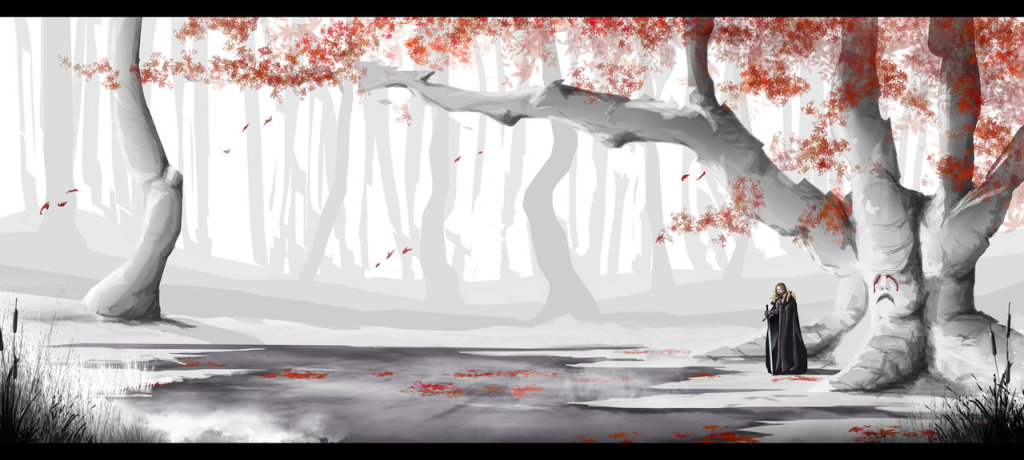
The Weirwood (source)
The depiction of religions and magic
One staple of fantasy is to have a fairly unambiguous mythology for the world. But the world of ASOIAF is not so clean-cut. The several cultures we see have various gods and religions of all sorts of varieties and fervors.
From the monotheistic, fundamentalist worship of the Lord of Light, to the institutionalism of The Seven throughout most of Westeros, to the local, born-again cult of the Iron Islands, to the spiritual zen of the Old Gods: the wide variety of religions and their roles in people’s lives add a sense of realism to the world.
I also love how the magic system is portrayed ambiguously: It definitely exists (and is definitely a powerful force), but it isn’t tied exclusively with any one religion. The entire depiction of magic and religion implies that there’s some sort of pantheism making the mystical world of the story tick.
There’s something scary and primal in the magic in ASOIAF — whether it’s the explicit magic we see (bodies resurrected; murderous shadow babies), the vague prophecies (like in the House of the Undying), or the lingering vestiges of magic (like the nagging sense that some sinister, sacrificial magic created The Wall). Martin’s brooding — and sparing — depiction of magic is always compelling.
The deconstruction of male-centric fantasy cliches
The depiction of gender in fantasy is a VERY prickly subject. The fantasy genre — stereotypically loved by basement-dwelling, nerdy males — has rarely been on the progressive edge of culture. Even works that claim to have some sort of female empowerment (like Wheel of Time) are often accused of falling into shallow portraits of anyone lacking a Y chromosome.
Thus, it’s intriguing how directly Martin tackles gender norms. Sure, his world is basically medieval Europe: the men rule, the women serve. But Martin not only has a female character who rises to power and becomes a sort of feminist icon defying the men who would try to control her (Daenerys), but he has an astounding number of strong women and girls in his story. Arya is a favorite, and Catelyn is the stoic mama bear. Queen Cersei, who is neurotic and eccentric and openly admits to having penis envy, is perhaps the most fascinating female character of all — at once subverting the stereotypes and living out extreme versions of them.
(And that’s barely the tip of the iceberg. There’s also Brienne, Sansa, Maergery, Asha, etc.)
It’s not perfect, and it still feels like Martin caters to horny men a bit too often, but his depiction of the complexity of gender is refreshingly mature, and in line with how grown-up other aspects of the world feel.
It’s just good
A Song of Ice and Fire isn’t just some shit that happens… it’s some Shakespearean, Dickensian, Homeric, dramatic, tragic, heartbreaking, OMFG shit that happens. This is story in a classical sense but pumped with steroids and blown up to epic proportions.
And all along the way, it always feels like it means something, like there are some crucial truths that Martin is slowly unraveling and revealing to us. I think THAT’S why I can’t put these books down, why their phone book-esque hugeness never deters me. It’s because it always feels like these silly stories of dragons and battles and magic actually MATTER.
As I think back on the series, I marvel at how every piece of it just seems to work. The language, the worldbuilding, the plotting, the characters, the cliffhangers, the comedy, the action, the violence, the social commentary, the high politics, the low thrills, the mysticism, the beauty, the danger… it’s truly a series that has a little bit of everything and makes all of it work.
A brief retrospective on the series:
A Game of Thrones (1996)
The one that started it all remains one of the strongest entries in the series and one of my favorite books, period. It chronicles the diaspora of the Starks from their home in Winterfell all across the world after Ned Stark accepts a position as an advisor to the king.
Highlights include Tyrion’s negotiation to freedom, Ned Stark’s honor-bound steadfastness in a treacherous political landscape, Arya’s “dancing lessons,” Cersei’s warning that “you win or you die,” Dany’s reign as “khaleesi,” and that final (now-famous) twist that let’s you know that no characters are safe George RR Martin’s authorial hands.
A Clash of Kings (1999)
An excellent sequel that explores a five-way struggle for the throne. Characters are deepened (and several are added) as the main characters start to take sides against each other.
Highlights include Tyrion’s cleverness as the Hand of the King, Arya’s three wishes, the Battle of Blackwater Bay, and Dany’s surreal visit to The House of the Undying.
A Storm of Swords (2000)
Not just the best book in the series, but one of my two or three favorite books, period. ASOS is an incredible payoff on the first two books of the series, giving us plot twist after exciting plot twist, scene after perfect scene.
In the aftermath of The War of the Five Kings, just when things should be settling down, various seeds of dissent and drama planted throughout the first two books cause shit to repeatedly hit the fan.
Highlights include basically every chapter in the final two thirds of the book. But my favorite moments are Jon Snow’s stint with Ygritte and the wildlings (and its aftermath), Arya’s pairing with The Hound, the unexpected betrothal of two central characters, Dany’s rise to power, Sam becoming Sam the Slayer, Jaime and Brienne’s journey back to Kings Landing, and — yes — the Red Wedding.
It’s really incredible how much story and thematic coherence is packed into one book (even after you consider that there’s more than a thousand pages).
A Feast for Crows (2005)
In my mind, this easily the weakest entry in the series. Coming off the torrid pace of A Storm of Swords, Crows dials the pace back and leaves out several of the series’ best characters.
Highlights are few, but Cersei’s gradual descent is at least moderately compelling, and Arya’s “Valar Morghulis” journey is a welcome respite from the Dorne and Kings Landing shenanigans. My favorite story might be Sam’s, though, as he begins a new journey with Gilly and (the ever-underrated) Maester Aemon by his side.
A Dance With Dragons (2011)
This massive tome is an upgrade from Crows, if not quite as riveting as the previous three in the series. After disappearing for a book, Tyrion, Dany, and Jon are back. Of those three, Dany’s adventure feels like a huge drag as she tries to rule a city we have almost no interest in, while Tyrion’s story lacks truly memorably companions for The Imp. It’s Jon’s story that really shines this time around: his struggle to bring some sort of order to the upended Night’s Watch is dramatic and fascinating.
The Winds of Winter (20??) and Beyond:
Martin is a famously slow writer, as the release dates of the previous books indicate. Since A Storm of Swords, we’ve had to wait at least a half decade between new entries in the series. I hooked on to the series right around the time ADWD was released, so this three-year wait is the first one I’ve had to deal with, and it definitely is painful.
Martin has continually upped the number of books he promises in the series. The current number is seven, with Martin hinting that he might have to bring it to eight. I’m anxious to read what’s next, but I also don’t mind waiting — I’d rather they be good and tardy than disappointing and punctual.
But what I know for sure is that it has been a hell of a ride so far, and I’m excited that there’s still a long way to go in this series.


